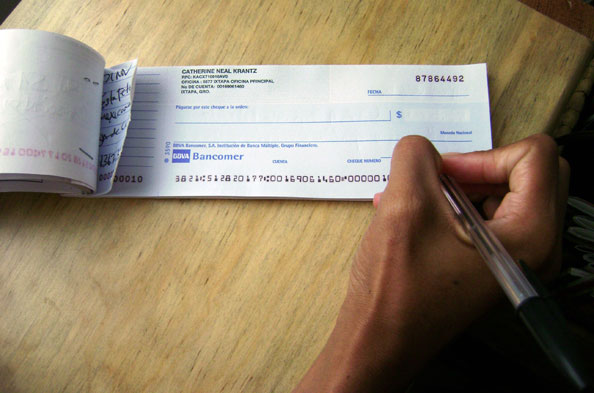Most of us extranjeros (foreigners) want to make our lifestyle in Mexico more convenient. One of the first steps towards doing so is opening a Mexican bank account…
The ability to pay bills and have easy access to cash makes a big difference when you are residing in a foreign country. A local bank account alleviates the hassle of costly international ATM and credit card fees. It also eliminates the need to make international wire transfers, which often end up getting lost or take days to finalize, leaving you in a potentially precarious (and cashless) situation. Most local banks allow you 24-hours a day, 7-days a week, online access to your checking and savings account along with the ability to pay certain bills online such as utilities, phone or internet. If you need to make payments to persons or businesses, many online banking services allow you to make direct deposits or direct transfers from your account into any other Mexican account, and you can also request physical checks which can be cashed at the issuing bank or deposited in any Mexican bank account. This article aims to provide you with the basic information and “how to” for opening a bank account here in Zihuatanejo.
First and foremost, there are certain documents you will need to bring in order to open a bank account:
1. Forma migratoria
Whether it be an FMT (the tourist card which every foreign passport holder is given upon entry into Mexico), FM3 or FM2. For FM3/FM2 visa holders, you will need to make a copy of all of the pages within the visa even if they are completely blank.
2. Comprobante de identificacion official
In other words, your passport. Here as well you will need a copy of the entire passport including all of the pages, even if they are completely blank.
3. Combrobante de domicilio
Proof of residence, which can be in the form of a recent (up to three months prior) utility, phone, cable or Telcel bill. Most banks will accept proof of residence even if it’s not in your name. This is generally the case for anyone who is renting and receives a monthly bill in the name of the landlord or owner. In this case, the recommendation is to bring along your current rental contract (original and copy) because although it’s not required they may ask you for it.
As each bank operates independently, additional documentation may be requested. Nevertheless all banks require you to deliver at minimum what is listed above. Each bank will also require you to fill out an application packet which is fairly comprehensive. The procedure for processing all of the paperwork is often lengthy; it can take up to a month or more to get your account set up. Once your account has been approved, you should be issued an ATM debit card (and PIN number). If the ATM card carries a Visa or Mastercard logo then you can also use it wherever credit cards are accepted. This is especially handy when buying groceries, eating out and paying for gas (at selected Pemex stations). Should you want to set up online access for your account, you will need to submit a request to your account executive. Regarding account fees, online access, check writing privileges and bill payment services, each bank has established their own policies so for the most up to date information it’s best to check directly with an account executive at the local branch.
Some things that are helpful to keep in mind when filling out the required application packet is that your signature must be consistent and must be signed exactly the way it appears in your passport. Any small disparity will have you back at the bank filling out an entirely new application packet and starting the process all over again. It’s also important to fully understand your bank’s check writing policies. For handwritten checks, orthography is crucial. Misspelled names or peso amounts (which must be written out in Spanish), will result in check refusal. Also any corrections or cross outs on a check may result in its refusal. This is extremely inconvenient for whoever is trying to cash or deposit your check as wait times at the bank are often lengthy. As with any checking account, always verify you have sufficient funds as each bounced check can cost you up to 80US dollars, depending on the bank policy.
Another advantage to opening a Mexican bank account is that you can begin to establish a financial history. Although Mexican credit cards come with very high interest rates, in order to apply for one you will need to have had a Mexican bank account for at least six months to a year. Similarly if you are interested in taking out a loan or mortgage in pesos, part of the approval process will be based on your account history. Additionally if you have a business here it is required that you open a Mexican account for tax reporting purposes.
Although a time consuming and arduous process, opening a Mexican bank account can save you a lot of grief, time and money in the long run and if you plan on residing in Mexico for any extended period of time, it will be one of the first steps towards making this country feel more like home.




